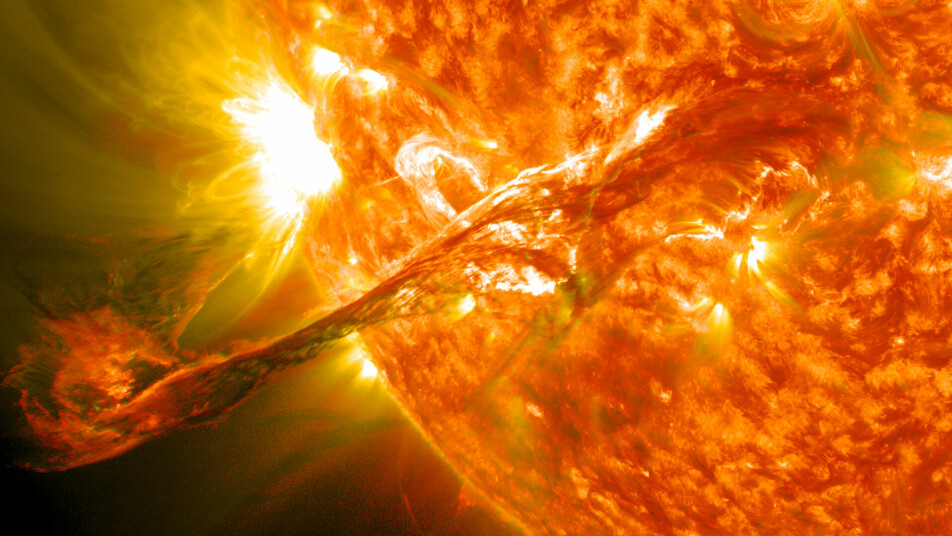
New spacecraft to solve mystery: Why is the Sun's atmosphere a hundred times hotter than its surface?
Norwegian scientists will help create a spacecraft for NASA, which aims to solve one of the deepest mysteries in physics.
Most of us know this quite intuitively:
The further away from a heat source you get, the colder it gets. We move closer to the fire to warm our toes, and back off a little when we get too hot.
But something strange is happening in the Sun.
The core of the Sun is a staggering 15 million degrees Celsius. The temperature then gradually drops outwards towards the surface, where it is approximately 6,000 degrees. From there, it would be reasonable to think that the temperature would decrease even more in the corona, which is the Sun's atmosphere.
But in the 19th century, scientists discovered something very startling.
Several million degrees
During a total solar eclipse in 1869, two different scientists had set up spectrometers pointing at the Sun.
A spectrometer can use light to determine which elements are present in the source of the light. The eclipse made it possible for the researchers to measure just the light from the corona, which protruded around the edge of the Moon as it covered the Sun.
But they were completely puzzled by the spectrum of light that appeared in the instrument. It was unlike anything the researchers had seen before. At first they thought it was a completely new substance.
Not until the end of the 1930s did the Swedish researcher Bengt Edlén clarify what the spectrometer actually showed.
The signature the researchers measured was not from an unknown substance at all, but rather from iron atoms, where as many as 13 of the electrons had been torn away from the atom.
For that to happen, the temperature would have to be extremely high.
The researchers quickly calculated that the corona must have a temperature of several million degrees. Since then, countless measurements have confirmed this. But how is that possible?

Still don’t know why
Today, 80 years later, this question still remains unanswered, says Professor Viggo Hansteen.
Hansteen is a professor at the Rosseland Centre for Solar Physics (RoCS), a Research Council of Norway Centre of Excellence at the University of Oslo. Most of the time, however, he works at the Lockheed Martin Advanced Technology Center (LMATC) in the USA.
“We know this has to do with the Sun's magnetic field, but we don’t understand the details,” he said.
The researchers believe that energy from just below the surface of the Sun is transported into the atmosphere by the Sun's strong magnetic field. Up in the atmosphere, the energy is released in short bursts that make the nearby gases extremely hot.
No one knows for certain if this is what is actually happening.
Observations from the IRIS spacecraft have given hints that such an explanation may be correct. But the answer is uncertain. IRIS is too slow when it makes images.

Thin strips of light
Today's measurements of the Sun's corona are actually based on the same principles as the old-fashioned spectrometer: Light travels through thin slits and is spread, allowing colour spectrum in the light to emerge.
The problem with this technique, however, is that you can only look at a small area – a thin strip of light.
But to understand the magnetic phenomena on the Sun, researchers need a broader view of the situation, says Hansteen.
“It looks as if the structures that get hot are large, but much of what happens happens on a small scale and quickly,” he said. “So we need to look at large areas and details at the same time.”
In the past, the only solution has been to take many pictures while moving the instrument little by little. Together, all these thin slices form a picture of a larger area. But this process takes time. And phenomena on the Sun happen very quickly.
“It takes a minute or two to take a complete picture. When things happen over just five to ten seconds, we can't keep up,” Hansteen said.
This is where the new spacecraft comes in.
Hard competition
The spacecraft is called the Multi-slit Solar Explorer (MUSE) and is a collaborative project between the American space agency NASA, Lockheed Martin Advanced Technology Center and Rosseland Centre for Solar Physics (RoCS) at the University of Oslo.
Hansteen and his colleagues at RoCS and Lockheed Martin had been working on this very problem for several years and came up with one possible solution to the challenge posed by IRIS.
They found a way to collect the light from a total of 37 slits in one receiver, and then separate each of the images from each other afterwards. It may sound simple, but is a very difficult process.
When NASA called for projects to investigate the solar atmosphere a few years ago, Hansteen and his colleagues threw themselves into the competition.
It was demanding to convince NASA that the research team had really managed to separate all the images from each other, Hansteen said. But in the end they succeeded. NASA wanted them on the team.
Terje Wahl, scientific director for the Norwegian Space Agency, believes there is good reason to be satisfied.
“It’s always like trying to pass through the eye of a needle when NASA announces a competition for new ‘missions’ in its science programme,” he wrote in an email to sciencenorway.no.
“We can all be proud that the American researchers believed that RoCS was so good that Norwegian participation would strengthen the application's chance of winning the NASA competition,” he said.

Launch in 2026
The researchers have now started a major effort towards a planned launch of MUSE in 2026. The researchers at RoCS are working on the theoretical aspects of the project, while NASA is responsible for the actual construction and launch. Altogether, the project has a budget of US $192 million.
After the launch, MUSE has funds to operate for three years, but it is fairly common for such projects to be extended, Hansteen said.
“The vessels are built to last longer. The lifespan is often at least ten years. The Sun has an 11-year cycle, and it would be useful to get observations from an entire cycle,” Hansteen said.
The data that MUSE eventually collects will become openly available, so that all researchers can use it.
So what should the data be used for?
Most interested in understanding
What happens in the solar atmosphere has direct effects on the Earth. Strong solar storms can, for example, damage electronics and the power grid. These storms can also be problematic for satellites and spacecraft, and in the worst case, life-threatening for astronauts.
Consequently, it’s important to be able to forecast space weather. And more knowledge about the solar atmosphere will provide better models for predicting what will happen.
But it is not primarily better space weather forecasts that have inspired Hansteen. Instead, it’s the same driving force that probably made the scientists in the 19th century set up their spectrometers in front of the solar eclipse.
“What primarily interests me is how the world fits together,” the professor said.
What physical processes are behind the wonderful phenomena on the Sun?
Only the future can tell whether this research can be linked to something that will be useful in everyday life, Hansteen said.
He’s not unlike the scientists who, in their time, experimented with the strange phenomenon they called electricity, without having the remotest idea that it would ever find practical use.
Translated by Nancy Bazilchuk
———
Read the Norwegian version of this article at forskning.no
------

































